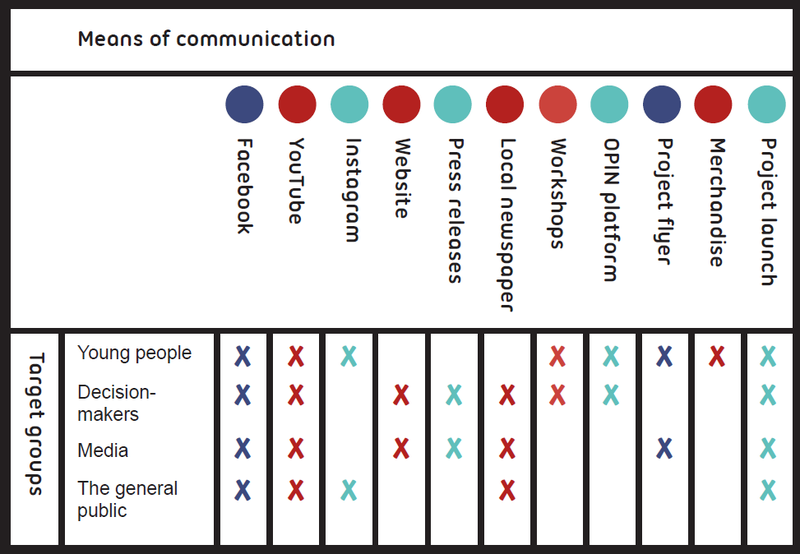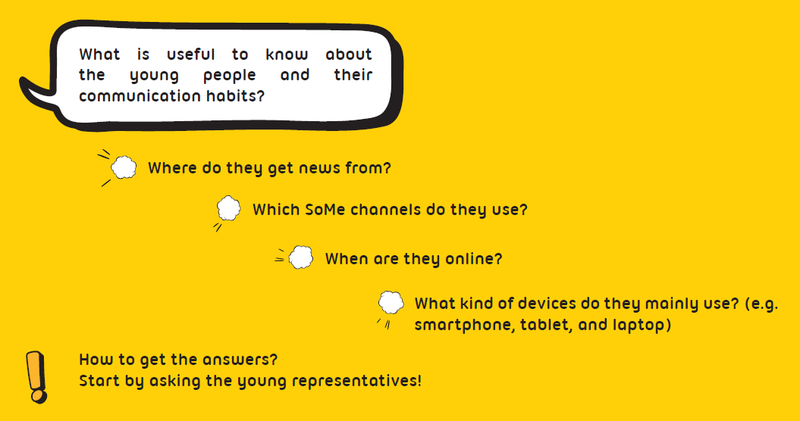Communication strategy
Contents
Compose a communication strategy to be publicly visible
The purpose of a communication strategy is to raise awareness of your project. You often want this for two reasons: 1) To capture the attention of young people so they will participate in your project; and 2) to achieve impact with your project. Communicating about your project will increase its visibility which will hopefully strengthen the commitment of both the young participants and the decision-makers.
You need to prepare a strategy that targets each of your target groups. Composing a strategy can be complex, but it does not have to be. You have already mapped your main target groups – the young people and the decision-makers – so now you just need to decide on the main messages you want send to them and how to get these messages across. Creativity knows no bounds for what exactly this how can be. To give a few examples, it could be promotion stickers for laptops and keychains, happenings at local schools, YouTube videos with young project ambassadors advocating for the project, a project flyer, an interview in the local newspaper, a press release, and so forth. In conclusion, the how depends on the desired target of the message and resources available.
Besides the young people and the decision-makers, it can be useful to communicate about your project to a wider audience. This effort will increase the awareness of your project, and you will potentially win important stakeholders over, and they might help to get your messages across. Speaking of stakeholders, you should start by identifying the people and organisations that also have a stake in the decisions to be made or youth eParticipation in general. In so doing, you should think broadly – both with regards to the different types of stakeholders (from the big company to the small interest group) and the whole spectrum of interest.
The next step is to prepare targeted communication efforts. This includes making an overview of the different means of communication which you will use to communicate with your different target groups. See a guiding example below which could of course be further elaborated:

It is important that you consider communication as a continuous task which runs throughout all phases of your project. Keep the young people, the decision-makers and other stakeholders continuously updated on project developments to hold their attention. To ease this work, we recommend preparing a detailed plan where each communication activity is described and scheduled. You should take the timeline of the project activities as your starting point. The first message you could communicate to a wider audience is that the, let’s say, municipality is in the process of organising a youth eParticipation project – that is a story in itself! It is very important that you start as early as possible to communicate about the project, so it is already known before the actual participatory process is kicked-off. And speaking of kick-off, you could organise a grand project launch which convinces everyone to be involved!
If your project organisation is not already present on social media (SoMe) you could create an account on one or several of these channels. You should of course pick the channel(s) where young people are already present, so they will see your updates and tweets, and hopefully share them with their network. If you have established a steering committee with young representatives, ask them which SoMe channels are the most commonly used because this highly depends on country and age group. In addition, it can be useful to create a hashtag (#) for your participatory project to be used to facilitate the online dialogue about your project, not just on the OPIN platform but across different SoMe channels too.
And one last thing: When you design your communication products, make sure to avoid copyright infringements! Everything from pictures, sound recordings to literary works can be covered by copyright. Check out Creative Commons for more information on this topic.
